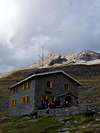-
 16990 Hits
16990 Hits
-
 81.18% Score
81.18% Score
-
 13 Votes
13 Votes
|
|
Mountain/Rock |
|---|---|
|
|
42.66960°N / 0.04320°E |
|
|
10675 ft / 3254 m |
|
|
Overview
Of three big mountains that there compose the Tres Sorores (three sisters), Cilindro de Marboré, Monte Perdido, and Añisclo, the latter is least known and frequented of the three, in spite of the magnificent aspect that it presents specially from Monte Perdido's summit. Probably the cause is a more complicated route, less height and on having had to compete with a wonderful mountain as the Monte Perdido that stays excessively nearby. Among the mountaineers that love Ordesa's valley it's habitual to include this mountain in the options to flee of the mass of his famous neighbor (probably of every 100 persons who visit the zone only 1 or 2 climb the Añisclo).In spite of everything the difficulty of 2 normal routes is not excessive, the route of the escaleras-couloir NW is F + (Easy sup.) and the route of Añisclo's col is F (Easy), but it is a question of itineraries with parts out of path, many inconvinient stones and hard slopes. The general idea is a night in Góriz's mountain hut to climb the summit the second day.
Who's Ramond (the name)
Louis François Elisabeth Ramond de Carbonnières (1755-1827) was the father of the Pyrineism. He received an important literary and scientific education but in 1787 he discovered the Pyrenees and began to study the glaciers and the geology but especially the botany. After listening that probably the highest mountain of the mountainous chain was the peak of Maladeta realized the first attempt of ascension recognized on August 21, 1787. But in spite of the great love that he was feeling for the whole zone of the Central Pyrenees he was seduced by the Monte Perdido, the mountain which one would be joined inevitably for the history and the legend. He thought that probably Monte Perdido was the highest mountain and he carried out a great scientific expedition to try to reach the top in August, 1797. In spite of big efforts for difficult routes, even today, he needed three attempts and until 1802 he did not manage to conquer the summit. He realized many altimetric campaigns between 1813 and 1816 and knew that the mountain of his dreams was not but the third one of the Pyrenees after Aneto and Posets.In 1856 the second generation of Pyrineists, Russell, Schrader, Frossard, Maxwell-Lyte and Packe, they founded the "society Ramond" to continue his work and spirit and, in 1872, the famous cartographer Schrader named and important peak without name, well-deservedly, as Soum de Ramond.
The name Añisclo is most geographic because this peak is over the Añisclo's canyon.
Getting There
The approach to Ordesa's valley is perfectly described in other mountains of the zone as Monte Perdido, and I will not comment on it not to repeat it again.Red Tape
No need for permits or summit fees.From 1th July to 12th October, and Holy Week, the access to Pradera de Ordesa is forbidden to cars and the ascent is in bus (2,20€ and 3,10€ with return). Horary: 6 to 19h (july-august), 7 to 18h (rest). Last return: 21h (july-august), 20:30h (rest).
The mountain is located in a National park. The National Park Rules:
-Sports aside hiking, climbing, ski-mountaineering and speleology are forbidden.
-sale of commercial products is not allowed
-It's forbidden to swim in the rivers, streams and lakes
-It's forbidden to walk out of path.
-see camping section below to complementary info about it.
When To Climb
Summer time is the best and most secure season (july to september). Early in the season (or june) the snow remain in the coulouir NW and the little glacier (west) is covered by the snow and is harder.Out of the season is only for expert in winter conditions with some interesting coulouirs (west or "Burra Pelayo", the normal NW or the couluoir NE)
Camping
Free camping is forbidden. It's permited to camp using a little tent , wich would be taken down at dawn: Ordesa: 2.100 m (Clavijas de Soaso), Añisclo: 1.800 m (Fuen Blanca), Escuaín: 1.800 m (La Ralla), Pineta: 2.500 m (Balcón de Pineta)Mountain Conditions
I.N.M. (see province "Huesca" in section "provincias", and in section "localidades" see the village of "Torla")External Links
- National Park of Ordesa
Page of National Park with interesting information.
- Ramond de Carbonnières information about this mythical pyreneist (french)













